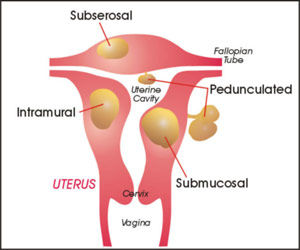ABOUT THE DISEASE
Uterine fibroids are non cancerous (benign) growth of muscle and connective tissue from the wall of the uterus. They range in size from 1 mm to more than 20 cm in diameter.
Depending on their location, fibroids can be described as -
- Myometrial/Intramural
- Subserosal
- Submucosal
- Pedunculated

Almost 20% of women above the age of 35 have been detected with this disease.
SYMPTOMS
Some women might not feel any of the below symptoms, others might suffer from:
- Heavy bleeding during menstrual period
- Extended duration of menstrual periods
- Pain during intercourse
- Heaviness in the lower pelvic area
- Constant urge to urinate
- Infertility
DIAGNOSIS
- Pelvic exam
- Pelvic ultrasound
- Endometrial biopsy, to rule out malignancy.
Treatment prescribed is based on factors such as the patient`s age, severity of problem, whether the patient is pregnant or wishes to have kids in the future.
Non surgical options include hormonal therapy to shrink the fibroids, iron supplements (to counter anemia), Intrauterine devices and contraceptive pills.
Surgical Options include:
- Hysteroscopic resection of fibroids
- Uterine artery embolization
- MRgFUS / HIFU
- Myomectomy
- Hysterectomy
You may also like to learn about:
Dysfunctional uterine bleeding (DUB)
Menorrhagia
Menopause
Uterine cancer
Endometriosis
Polycystic ovarian disease (PCOD)